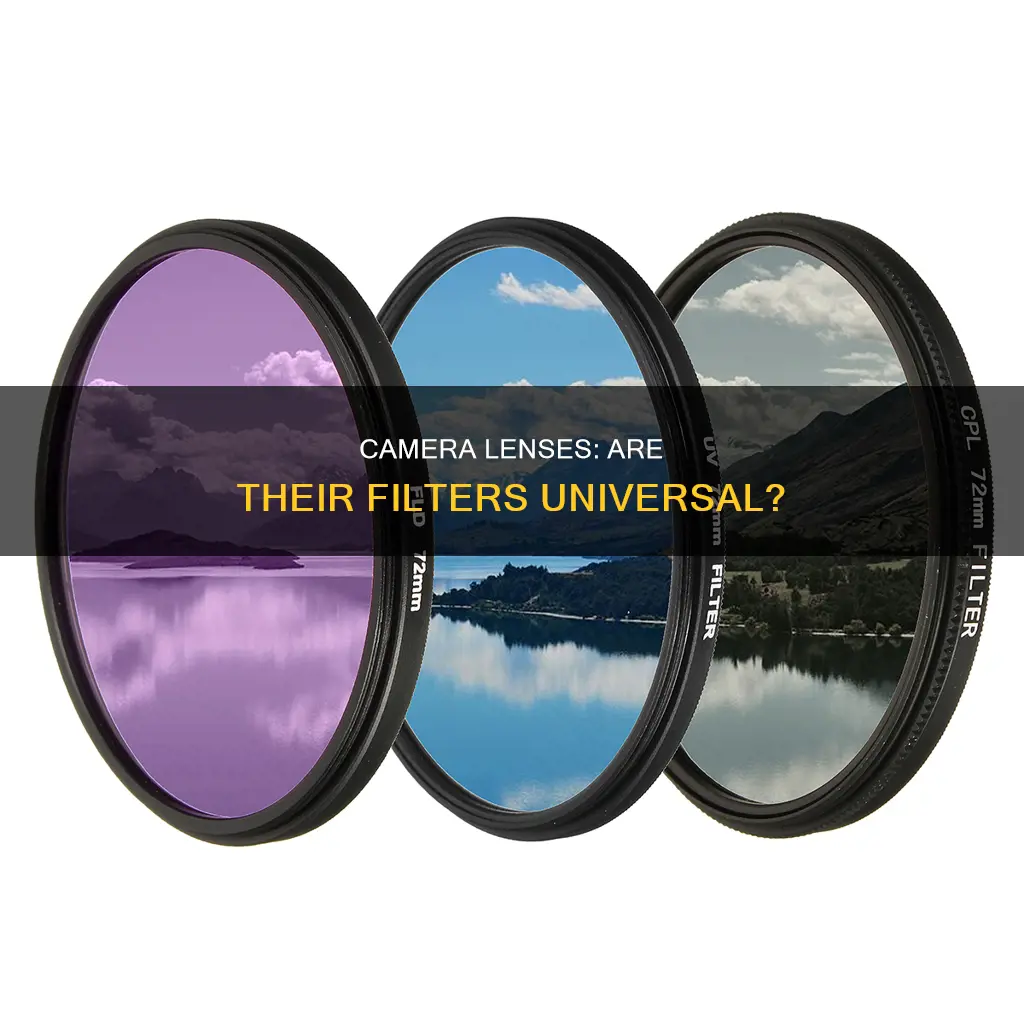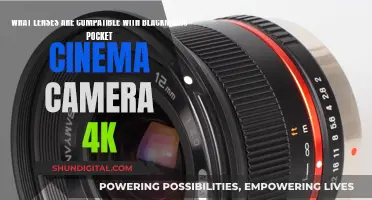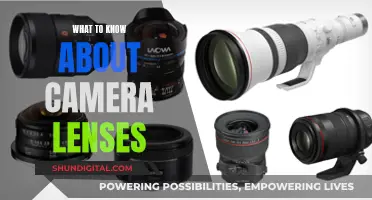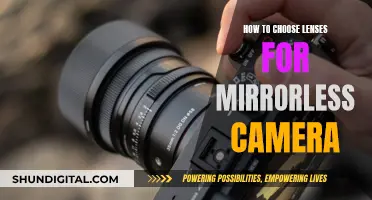
Camera lens filters are an essential tool for photographers, offering protection from scratches and dust and enhancing images by managing tricky lighting conditions, reducing reflections, improving colour contrast, and creating special effects.
Filters come in different shapes and sizes and attach to the camera in one of two ways. The most common type is circular filters that screw directly onto the lens. The second method is to use a filter holder that accepts universal rectangular filters, which is useful if you want to use multiple filters to create different effects.
The type of filter you need depends on the type of photography you do. For example, landscape photographers rely heavily on filters, while street and portrait photographers rarely use them.
| Characteristics | Values |
|---|---|
| Purpose | Protection, managing tricky lighting conditions, enhancing colours, reducing light, adding impact to images |
| Types | Clear, UV/Haze, Skylight, Polarizing, Neutral Density (ND), Graduated ND, Diffusion and Soft Focus, Star, Close-up, Special Effects |
| Attachment | Circular (screw-on), Drop-in, Rectangular (with filter holder), Square |
| Material | Glass, Resin, Polyester, Polycarbonate, Plastic |
| Size | Varies, must fit the thread on the front of the lens |
What You'll Learn

Clear filters are used for lens protection
Clear filters are a type of camera lens filter used for lens protection. They are one of the most affordable types of camera lens filters and are used to protect the front lens element during normal shooting situations. They are clear and do not affect your images in any way.
Clear filters are great for protecting the front lens element from scratches, cracks, dust, and dirt. They are also useful when shooting in harsh elements, such as saltwater spray or dusty conditions. They can be left on the lens at all times and are ideal for shooting in wet, dusty, or muddy environments.
However, it is important to invest in a high-quality clear filter as cheap, low-quality filters can degrade image quality by causing ghosting, flare, and loss of contrast. High-quality filters, on the other hand, rarely degrade image quality and can be easily cleaned and replaced if scratched.
Some photographers prefer not to use clear filters as they believe that any glass in front of the lens will degrade image quality. They argue that lens hoods provide sufficient protection and that insurance coverage is a better contingency plan for lens damage.
Ultimately, the decision to use a clear filter comes down to personal preference, and there are valid arguments on both sides of the debate.
Best Places to Sell Your Camera Lenses Online
You may want to see also

UV/Haze filters reduce haze and act as lens protectors
UV/Haze filters are used to reduce the effects of atmospheric haze, moisture, and other airborne pollutants that cause image degradation. They are especially useful when shooting in areas with intense ambient ultraviolet light, such as near large bodies of water, at higher altitudes, or in snowy conditions. These filters can also protect the surface of your lens from scratches, dust, moisture, and fingerprints.
When purchasing a UV/Haze filter, it is important to consider the quality of the filter. Higher-quality filters are made with optically purer and thinner glass that interferes less with the front element of your lens. They also have better anti-reflective and colour coatings, which can reduce lens flare and improve image quality. Additionally, the retaining ring on higher-quality filters is usually made of brass, which is less prone to denting and jamming than aluminium. While higher-quality filters can be more expensive, they can help ensure that your images are not compromised.
It is worth noting that UV/Haze filters may not have a significant impact on reducing haze in digital photography. This is because digital camera sensors already have some amount of UV filtration to protect them from UV light. However, UV/Haze filters can still be useful for protecting your lens and may have a slight effect on reducing atmospheric haze.
Camera Kit Lenses: Worth the Money or Worthless?
You may want to see also

Skylight filters reduce blues and correct haze
Skylight filters are a photographer's best friend when shooting under a clear blue sky. They can reduce the excessive blue cast that often appears in photographs taken outdoors. They can also keep skin tones free of colour reflections from objects that are around the subject.
Skylight filters have a subtle magenta tint and are available in two strengths: 1A and 1B. The magenta colouring can counterbalance the blue bias found in certain film stocks.
Skylight filters can also cut through atmospheric haze like UV filters, but they do not impact your camera exposure. However, with a skylight filter as your lens's protection, the image quality of your photos may be compromised as it can intensify lens flares that tend to add a colour tint and reduce image contrast.
Therefore, while skylight filters can reduce blues and correct haze, it is important to invest in a high-quality filter that will not detract from the overall quality of your images.
The High Cost of Camera Lenses: Why So Expensive?
You may want to see also

Polarizing filters reduce glare and enhance colours
Polarizing filters are an essential tool for photographers, enhancing images in ways that can't be replicated with digital editing software. They work by filtering out sunlight that's reflected directly into the camera at specific angles, allowing the remaining light to appear more diffuse and colourful. This can make images seem more vibrant, with richer blues and greens, and more saturated colours overall.
Polarizing filters are particularly useful for removing glare and reducing reflections from water, glass, and other polished surfaces. They can also be used to isolate objects that are wet, underwater, or behind a window. For example, a photographer can use a polarizing filter to select subjects that are reflected in the water or are underneath the water's surface. Similarly, a polarizing filter can be used to remove unwanted reflections when taking a photo out of a window or other transparent barriers.
However, it's worth noting that polarizing filters can sometimes reduce image contrast, making it harder to capture scenes with a broad dynamic range. They also require longer exposure times, as they discard some light, and can be tricky to use with wide-angle lenses, as they can cause vignetting.
Renting Camera Lenses: Best Places to Get Them
You may want to see also

Neutral density filters reduce light entering the lens
Neutral density (ND) filters are a type of camera lens filter that reduces the amount of light entering the camera. They are often used to manage tricky lighting conditions and are available in different strengths or darkness levels. ND filters are typically made of glass and are placed directly in front of the lens, either by screwing them on or by using a filter slot. They can also be rectangular or square-shaped and inserted into special holders attached to the front of the lens.
ND filters are particularly useful when a slower shutter speed is required to capture motion blur or when a wide-open aperture is needed under bright light conditions. By reducing the light entering the lens, ND filters allow photographers to use slower shutter speeds without overexposing the image. This can be especially effective for capturing motion blur in scenes with flowing water, such as waterfalls or rivers, or for emphasising movement in photographs with vehicular traffic, people, or seascapes.
ND filters are available in different strengths, typically measured in stops of light. For example, a 2-stop ND filter will block a smaller amount of light, while a 10-stop ND filter will block a significant amount. The stronger the ND filter, the longer the shutter speed that can be used. ND filters can also be stacked to increase their strength, although this may result in a loss of image quality due to the increased number of glass elements the light has to pass through.
In addition to their light-reducing properties, ND filters can also be used to achieve a shallower depth of field or to reduce the visibility of moving objects in a scene. They are a valuable tool for photographers, allowing them to have more control over the exposure and creative effects in their images.
Thailand Camera Gear: Are Lenses a Bargain?
You may want to see also
Frequently asked questions
Camera lens filters can help photographers manage tricky lighting conditions, minimize glare and reflections, enhance colours, reduce light coming into the lens, and protect the lens from scratches, cracks, dust, water, and fingerprints.
There are several types of camera lens filters, including:
- Ultraviolet (UV) or Haze filters
- Skylight filters
- Polarizing filters
- Neutral Density (ND) filters
- Graduated ND filters
- Diffusion and soft-focus filters
- Star filters
- Close-up filters
- Special effects filters
When choosing a camera lens filter, consider the following:
- Purpose: Do you want to cut reflections, achieve bold colours, or keep your shutter open longer?
- Lens compatibility: Check the filter measurement to ensure it fits your lens.
- Budget: Avoid the cheapest option, but also consider the quality of your lens.







